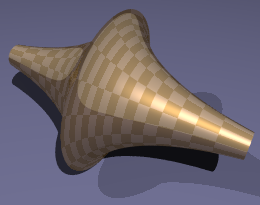Pseudosphere
In geometry, the term pseudosphere is used to describe a surface with constant negative Gaussian curvature.
More detailed description of the pseudosphere
A pseudosphere of radius R is a surface in having curvature −1/R2 in each point. Its name comes from the analogy with the sphere of radius R, which is a surface of curvature 1/R2. The term was introduced by Eugenio Beltrami in his 1868 paper on models of hyperbolic geometry.[1]
Tractricoid

The same surface can be also described as the result of revolving a tractrix about its asymptote. For this reason the pseudosphere is also called tractricoid. As an example, the (half) pseudosphere (with radius 1) is the surface of revolution of the tractrix parametrized by[2]
It is a singular space (the equator is a singularity), but away from the singularities, it has constant negative Gaussian curvature and therefore is locally isometric to a hyperbolic plane.
The name "pseudosphere" comes about because it is a two-dimensional surface of constant negative curvature just like a sphere with positive Gauss curvature. Just as the sphere has at every point a positively curved geometry of a dome the whole pseudosphere has at every point the negatively curved geometry of a saddle.
As early as 1693 Christiaan Huygens found that the volume and the surface area of the pseudosphere are finite,[3] despite the infinite extent of the shape along the axis of rotation. For a given edge radius R, the area is 4πR2 just as it is for the sphere, while the volume is 2/3πR3 and therefore half that of a sphere of that radius.[4][5]
Universal covering space
The half pseudosphere of curvature −1 is covered by the portion of the hyperbolic upper half-plane with y ≥ 1.[6] The covering map is periodic in the x direction of period 2π, and takes the horocycles y = c to the meridians of the pseudosphere and the vertical geodesics x = c to the tractrices that generate the pseudosphere. This mapping is a local isometry, and thus exhibits the portion y ≥ 1 of the upper half-plane as the universal covering space of the pseudosphere. The precise mapping is
where
is the parametrization of the tractrix above.
Hyperboloid
In some sources that use the hyperboloid model of the hyperbolic plane, the hyperboloid is referred to as a pseudosphere.[7] This usage of the word is because the hyperboloid can be thought of as a sphere of imaginary radius, embedded in a Minkowski space.
See also
- Dini's surface
- Gabriel's Horn
- Hyperboloid
- Hyperboloid structure
- Quasi-sphere
- Sine–Gordon equation
- Sphere
- Surface of revolution
References
- ^ Beltrami, Eugenio (1868). "Saggio sulla interpretazione della geometria non euclidea" [Treatise on the interpretation of non-Euclidean geometry]. Gior. Mat. (in Italian). 6: 248–312.
(Also Beltrami, Eugenio. Opere Matematiche [Mathematical Works] (in Italian). Vol. 1. pp. 374–405. ISBN 1-4181-8434-9.;
Beltrami, Eugenio (1869). "Essai d'interprétation de la géométrie noneuclidéenne" [Treatise on the interpretation of non-Euclidean geometry]. Annales de l'École Normale Supérieure (in French). 6: 251–288.) - ^ Bonahon, Francis (2009). Low-dimensional geometry: from Euclidean surfaces to hyperbolic knots. AMS Bookstore. p. 108. ISBN 0-8218-4816-X., Chapter 5, page 108
- ^ Mangasarian, Olvi L.; Pang, Jong-Shi (1999). Computational optimization: a tribute to Olvi Mangasarian. Vol. 1. Springer. p. 324. ISBN 0-7923-8480-6., Chapter 17, page 324
- ^ Le Lionnais, F. (2004). Great Currents of Mathematical Thought, Vol. II: Mathematics in the Arts and Sciences (2 ed.). Courier Dover Publications. p. 154. ISBN 0-486-49579-5., Chapter 40, page 154
- ^ Weisstein, Eric W. "Pseudosphere". MathWorld.
- ^ Thurston, William, Three-dimensional geometry and topology, vol. 1, Princeton University Press, p. 62.
- ^ Hasanov, Elman (2004), "A new theory of complex rays", IMA J. Appl. Math., 69: 521–537, doi:10.1093/imamat/69.6.521, ISSN 1464-3634
- Stillwell, J. (1996). Sources of Hyperbolic Geometry. Amer. Math. Soc & London Math. Soc.
- Henderson, D. W.; Taimina, D. (2006). "Experiencing Geometry: Euclidean and Non-Euclidean with History". Aesthetics and Mathematics (PDF). Springer-Verlag.
- Kasner, Edward; Newman, James (1940). Mathematics and the Imagination. Simon & Schuster. p. 140, 145, 155.
External links
- Non Euclid
- Crocheting the Hyperbolic Plane: An Interview with David Henderson and Daina Taimina
- Prof. C.T.J. Dodson's web site at University of Manchester
- Interactive demonstration of the pseudosphere (at the University of Manchester)
- Norman Wildberger lecture 16, History of Mathematics, University of New South Wales. YouTube. 2012 May.
- Pseudospherical surfaces at the virtual math museum.




